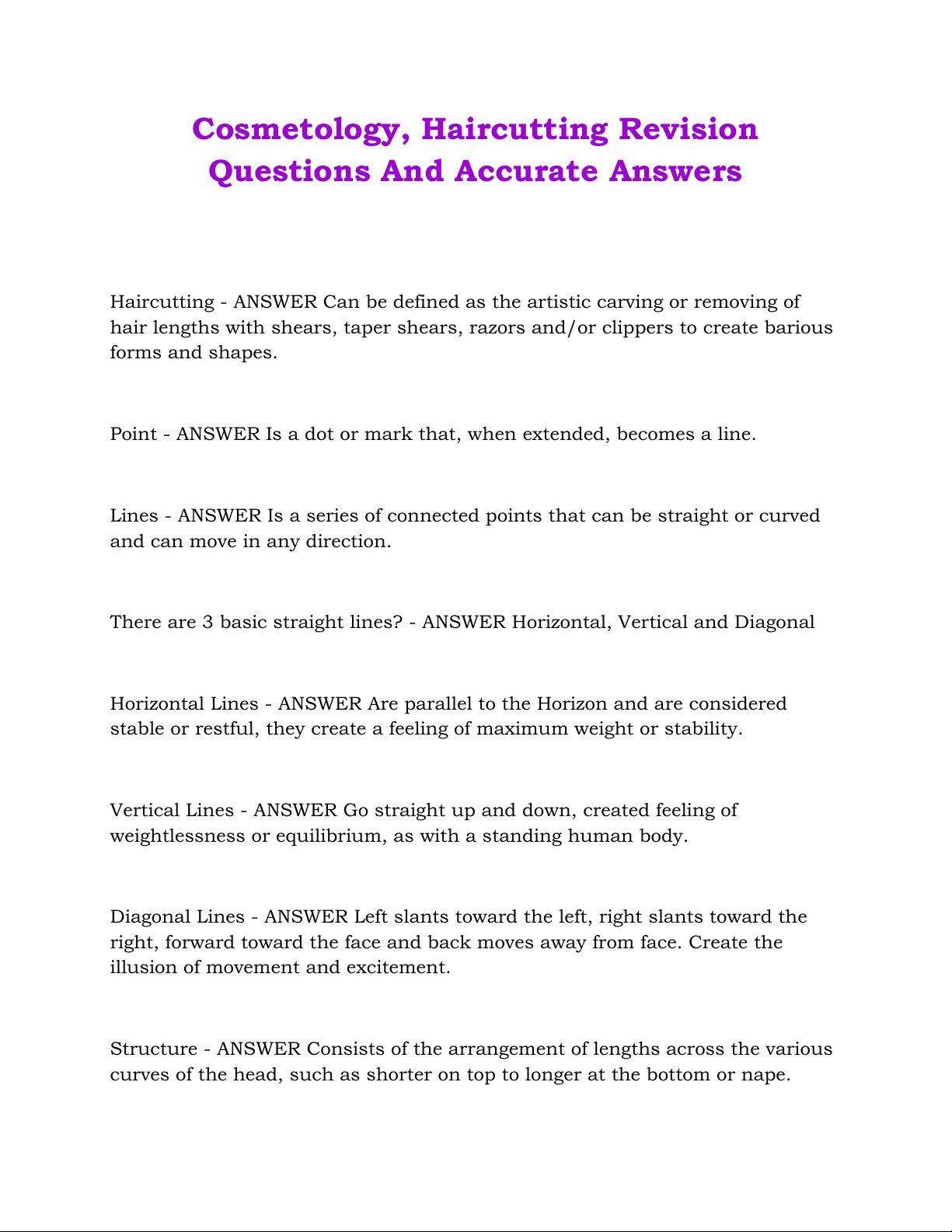
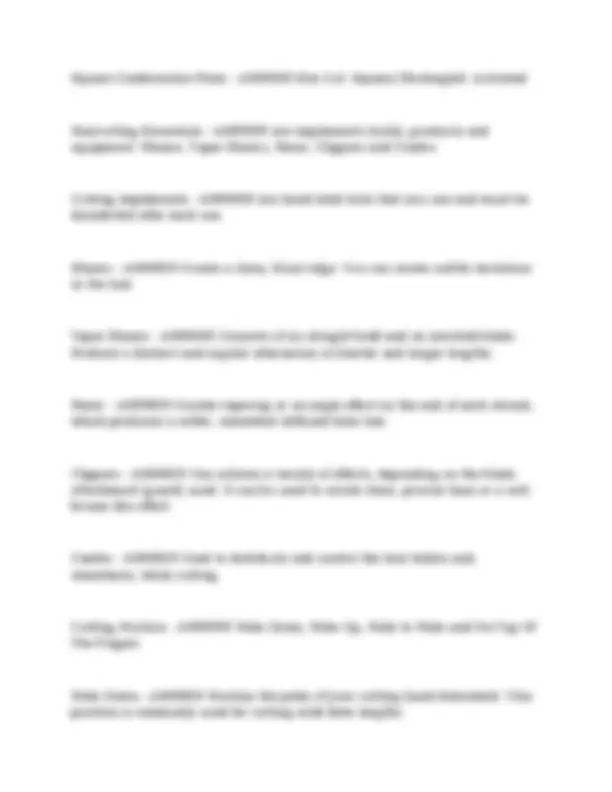
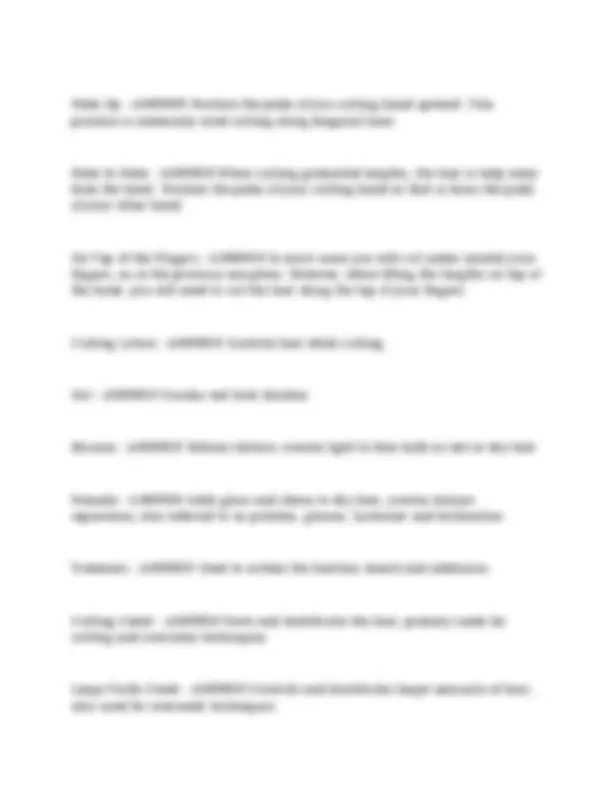
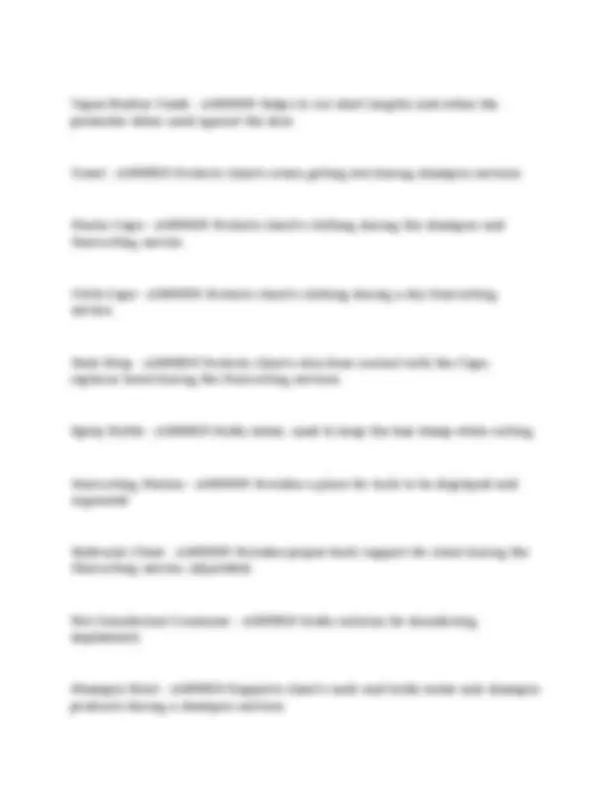
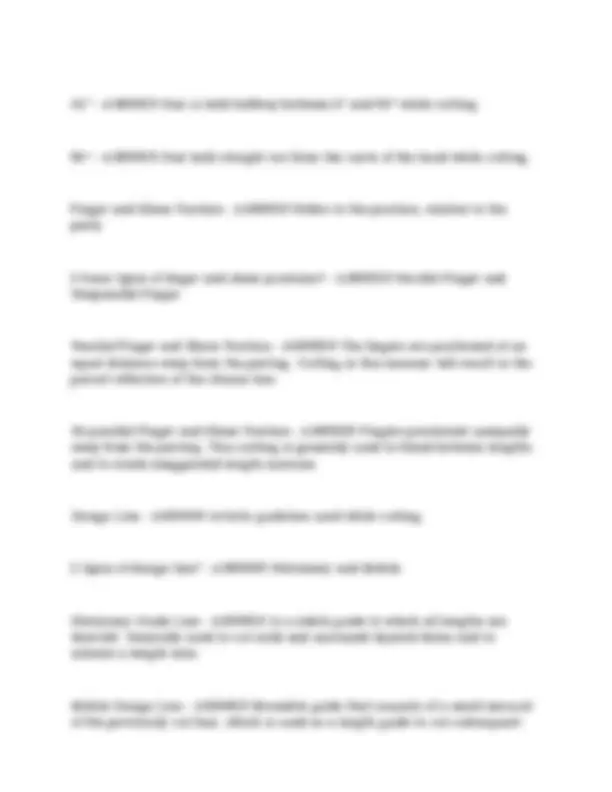
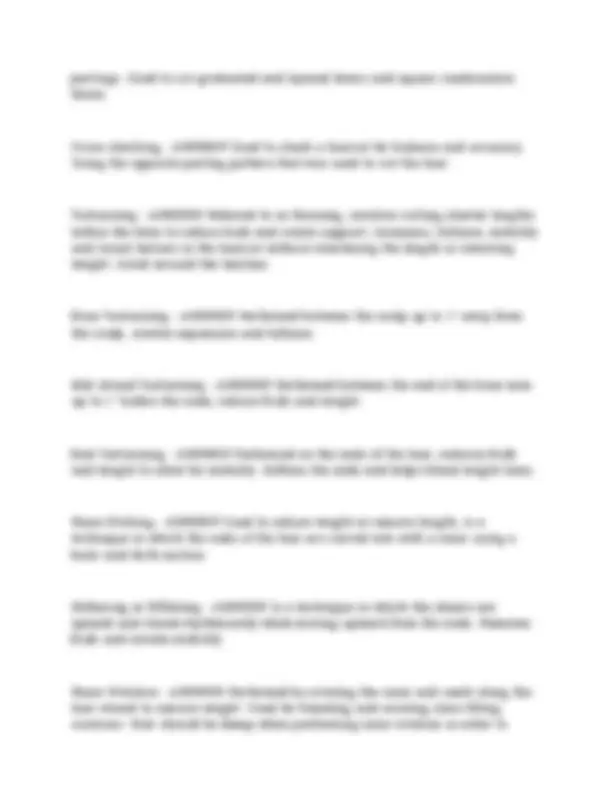
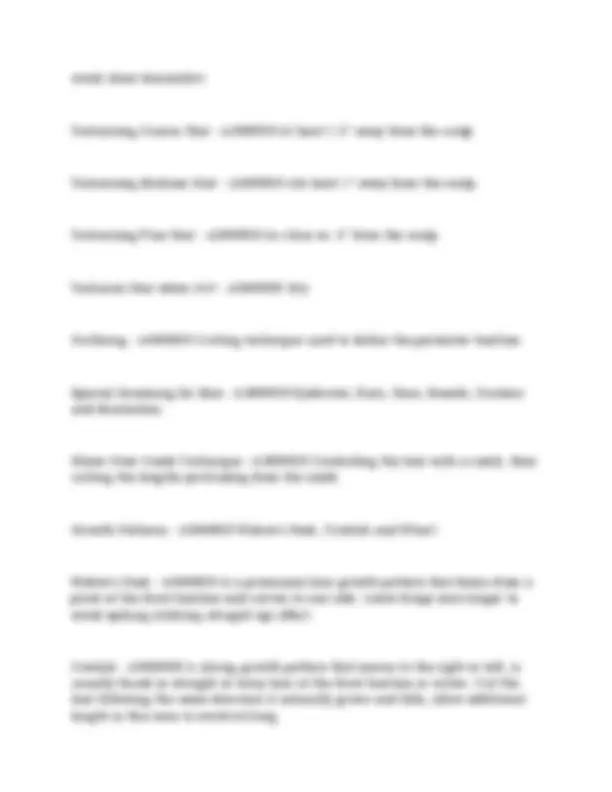


Study with the several resources on Docsity

Earn points by helping other students or get them with a premium plan


Prepare for your exams
Study with the several resources on Docsity

Earn points to download
Earn points by helping other students or get them with a premium plan
Community
Ask the community for help and clear up your study doubts
Discover the best universities in your country according to Docsity users
Free resources
Download our free guides on studying techniques, anxiety management strategies, and thesis advice from Docsity tutors
Cosmetology, Haircutting Revision Questions And Accurate Answers
Typology: Exams
1 / 11

This page cannot be seen from the preview
Don't miss anything!







Haircutting - ANSWER Can be defined as the artistic carving or removing of hair lengths with shears, taper shears, razors and/or clippers to create barious forms and shapes.
Point - ANSWER Is a dot or mark that, when extended, becomes a line.
Lines - ANSWER Is a series of connected points that can be straight or curved and can move in any direction.
There are 3 basic straight lines? - ANSWER Horizontal, Vertical and Diagonal
Horizontal Lines - ANSWER Are parallel to the Horizon and are considered stable or restful, they create a feeling of maximum weight or stability.
Vertical Lines - ANSWER Go straight up and down, created feeling of weightlessness or equilibrium, as with a standing human body.
Diagonal Lines - ANSWER Left slants toward the left, right slants toward the right, forward toward the face and back moves away from face. Create the illusion of movement and excitement.
Structure - ANSWER Consists of the arrangement of lengths across the various curves of the head, such as shorter on top to longer at the bottom or nape.
Natural Fall - ANSWER Describes the hair as the lengths lay or fall naturally over the curve of the head.
Normal Projection - ANSWER The hair is viewed abstractly as if it were projected at a 90* angle from the various curves of the head.
2 arms of the head are used to describe the length arrangement of a haircut? - ANSWER Crest and Interior
Crest - ANSWER Widest area of the head.
Interior - ANSWER Above the crest.
Solid Form - ANSWER A solid form is also known as a one-length cut, bob, Dutch boy, blunt cut or 0* angled cut. Rectangle. Unactivated.
Graduated Form - ANSWER Wedge or 45* angle cut. Triangle. Unactivated/Activated.
Increased-Layered Form - ANSWER Shag or 180* angled cut. Oval. Activated.
Uniformly Layered Form - ANSWER Layered cut or 90* angle cut. Circular. Activated.
Combination Form - ANSWER Two or more forms in any combination.
Gradation Form - ANSWER Short. Rectangle or Oval. Activated.
Palm Up - ANSWER Position the palm of you cutting hand upward. This position is commonly used cutting along diagonal lines.
Palm to Palm - ANSWER When cutting graduated lengths, the hair is help away from the head. Position the palm of your cutting hand so that is faces the palm of your other hand.
On Top of the Fingers - ANSWER In most cases you will cut under (inside) your fingers, as in the previous exa,pleas. However, when lifting the lengths on top of the head, you will need to cut the hair along the top of your fingers.
Cutting Lotion - ANSWER Controls hair while cutting.
Gel - ANSWER Creates wet-look finishes.
Mousse - ANSWER Defines texture; creates light to firm hold on wet or dry hair.
Pomade - ANSWER Adds gloss and sheen to dry hair; creates texture separation; also referred to as polisher, glosser, lusterizer and brilliantine.
Trimmers - ANSWER Used to outline the hairline, beard and sideburns.
Cutting Comb - ANSWER Parts and distributes the hair; primary comb for cutting and overcome techniques.
Large-Tooth Comb - ANSWER Controls and distributes larger amounts of hair; also used for overcomb techniques.
Taper/Barber Comb - ANSWER Helps to cut short lengths and refine the perimeter when used against the skin.
Towel - ANSWER Protects client's crime getting wet during shampoo services.
Plastic Cape - ANSWER Protects client's clothing during the shampoo and Haircutting service.
Cloth Cape - ANSWER Protects client's clothing during a dry Haircutting service.
Neck Strip - ANSWER Protects client's skin from contact with the Cape; replaces towel during the Haircutting services.
Spray Bottle - ANSWER Holds water; used to keep the hair damp while cutting.
Haircutting Station - ANSWER Provides a place for tools to be displayed and organized.
Hydraulic Chair - ANSWER Provides proper back support for client during the Haircutting service; adjustable.
Wet Disinfectant Container - ANSWER Holds solution for disinfecting implements.
Shampoo Bowl - ANSWER Supports client's neck and holds water and shampoo products during a shampoo services.
Perpendicular Distribution - ANSWER The hair is combed at 90* angle from its parting.
Shifted Distribution - ANSWER When hair is combed out of natural Distribution in and direction except perpendicular to its parting, it is known as shifted Distribution or overdirection.
Directional Distribution - ANSWER The hair is distributed vertically, or straight up from the head, and horizontally, or straight out from the head.
Projection or Elevation - ANSWER Is the angle at which the hair is help in relation to the curve of the head prior to and while cutting. The most common angles used are 0, 45 and 90*.
Angles between 0* and 30* are considered? - ANSWER Low projection.
Angles between 30* and 60* are? - ANSWER Medium projection.
Angles between 60* and 90* are? - ANSWER High projection.
Projection below 90* produce? - ANSWER Weight
Projection above 90*? - ANSWER Layer the Hair.
Natural Fall - ANSWER The natural position hair assumes due to gravity.
0* - ANSWER Hair is held flat to the surface of the head while cutting.
45* - ANSWER Hair is held halfway between 0* and 90* while cutting.
90* - ANSWER Hair held straight out from the curve of the head while cutting.
Finger and Shear Position - ANSWER Refers to the position, relative to the party.
2 basic types of finger and shear positions? - ANSWER Parallel Finger and Nonparallel Finger.
Parallel Finger and Shear Position - ANSWER The fingers are positioned at an equal distance away from the parting. Cutting in this manner will result in the purest reflection of the chosen line.
No parallel Finger and Shear Position - ANSWER Fingers positioned unequally away from the parting. This cutting is generally used to blend between lengths and to create exaggerated length increase.
Design Line - ANSWER Artistic guideline used while cutting.
2 types of design line? - ANSWER Stationary and Mobile
Stationary Guide Line - ANSWER Is a stable guide to which all lengths are directed. Generally used to cut solid and increased-layered forms and to achieve a weight area.
Mobile Design Line - ANSWER Moveable guide that consists of a small amount of the previously cut hair, which is used as a length guide to cut subsequent
avoid client discomfort.
Texturizing Coarse Hair - ANSWER At least 1.5" away from the scalp.
Texturizing Medium Hair - ANSWER Ate least 1" away from the scalp.
Texturizing Fine Hair - ANSWER As close as .5" from the scalp.
Texturize Hair when it's? - ANSWER Dry
Outlining - ANSWER Cutting technique used to define the perimeter hairline.
Special Grooming for Men - ANSWER Eyebrows, Ears, Nose, Beards, Goatees and Mustaches.
Shear-Over-Comb Technique - ANSWER Controlling the hair with a comb, then cutting the lengths protruding from the comb.
Growth Patterns - ANSWER Widow's Peak, Cowlick and Whorl.
Widow's Peak - ANSWER Is a prominent hair growth pattern that forms from a point at the front hairline and curves to one side. Leave fringe area longer to avoid spiking (sticking straight up) effect.
Cowlick - ANSWER A strong growth pattern that moves to the right or left, is usually found in straight or wavy hair at the front hairline or crown. Cut the hair following the same direction it naturally grows and falls; allow additional length in this area to avoid Ali king.
Whorl - ANSWER Strong circular directional growth on either side of the nape or crown. Allow additional length so the hair will remain flat, or cut the hair very close to the scalp to avoid spiking.
Client Consultation - ANSWER Greet, Ask, Analyze, Assess, Agree, Deliver and Complete.
Solid Forms - ANSWER Natural Fall and 0* Projection
Increase-Layered Form - ANSWER Directional Distribution and Parallel Finger/Shear Position.
Graduated Form - ANSWER Perpendicular Distribution and Medium-Low Projection.
Uniformly Layered Form - ANSWER Perpendicular Distribution and 90* Projection
Square Form - ANSWER Directional Distribution and Parallel Finger/Shear Position
Fade - ANSWER Clipper Cut